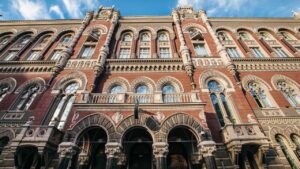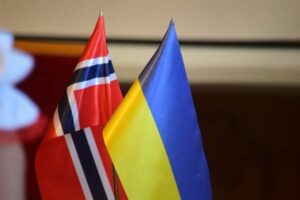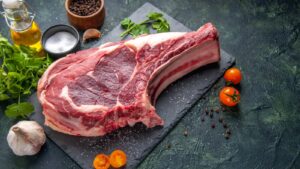
Last week, the National Bank of Ukraine (NBU) reduced sales of dollars on the interbank market by $234.8 million, or 27.9%, to $607.8 million, according to statistics on the regulator’s website.
According to the data released by the National Bank, last week the negative balance of buying and selling of foreign currency by banks’ legal entities increased from $43.2 million on Monday to $103.1 million on Thursday, which is almost half as much as last week.
A similar situation was observed in the market of foreign exchange transactions of households: while on Saturday-Monday, sales of foreign currency exceeded purchases by $7.6 million, on Thursday it was $10.5 million, while last Thursday this figure reached $27.5 million.
While a week earlier, for the first time in a long time, a negative balance was recorded in the segment of non-cash transactions of households, last week households again sold more non-cash currency than bought it – by $2-5 million daily.
The official hryvnia exchange rate against the dollar strengthened from 41.3895 UAH/$1 to 41.3401 UAH/$1 last week.
The same dynamics was observed in the cash market, where the hryvnia strengthened by 3-5 kopecks last week: buying to about 41.37 UAH/$1, and selling to about 41.45 UAH/$1.
“The Ukrainian currency market in terms of the dollar is in a calm phase – international factors do not provide drivers for drastic changes, while dosed interventions and liberalization of the NBU maintain low volatility and market controllability,” experts of KYT Group, a major participant in the cash foreign exchange market, said.
According to their estimates, domestic demand is stable without any hype or accumulative drivers, importers act in a planned manner without provoking abnormal outbursts, and there are fewer or no “insurance” margins of market operators in the hryvnia-dollar quotes.
For the next 1-3 weeks, KYT Group expects the exchange rate to remain in the basic range of UAH 41.30-41.85/$1: a break below UAH 41.20/$1 is unlikely without a strong external catalyst, but short impulses are possible based on data from the US or news about external financing for Ukraine.
In the medium term, for 2-3 months, the company expects the exchange rate to be 41.50-42.20 UAH/$1 and adds that the expectation of the September Fed decision with a likely but far from guaranteed rate cut shifts expectations for quotes to the lower end of the corridor. At the same time, autumn budget payments and energy imports may push quotes up, but the start of the export season and its success is a strong stabilizing factor.
“If the scenario of increased uncertainty (security, economic indicators, political shifts) or deterioration of external revenues is realized, short exits to 42.30-42.40/$1 are likely,” KYT Group experts believe.

Kyivstar, the largest mobile operator, announced the price of its May buyout of 28% of the digital healthcare platform Helsi, which allowed it to increase its stake from 69.99% to 97.99% for $11 million.
According to Kyivstar’s SEC report, this involves 26.9% of the shares of Ukrainian Investment Platform LLC and 1.1% of the shares of other minority shareholders.
It is noted that at the same time, previously concluded put and call option agreements for 30.01%, valued at $10 million at the end of March, were terminated and new agreements were concluded on the same terms for the remaining 2.01% of shares.
Kyivstar recalled that in August 2022, it acquired a controlling stake in Helsi of 69.99% for $15 million.
Helsi’s revenue for 2024 increased by 48% compared to 2023, to $5.1 million.
The report also mentions for the first time Kyivstar’s $2 million acquisition last September of LanTrace (Boryspil), a regional provider of fixed broadband Internet access in the Kyiv region.
According to YouControl, Samvel Akopian owns 96.3% of Ukrainian Investment Platform LLC, with Artem Mikhailiuk owning the remaining 3.7%.
Helsi is a digital data management platform that supports the provision of medical services by healthcare institutions and doctors and improves patient access to medical care, in particular by simplifying remote consultations and appointment scheduling, as well as medical data storage. As of January 1, 2025, the company had approximately 29 million registered patients with access to 1,600 public and private clinics and over 60,000 medical professionals. As of the end of 2024, the Helsi app had been downloaded by 10 million users, 2.5 times more than two years earlier.
As reported, the AMCU this week began considering Kyivstar’s application to purchase the owner of the online service Tabletki.ua, emphasizing that the combined share of the participants in the concentration in one of the markets involved in the concentration may exceed 35%. Kyivstar submitted its first application to acquire MTPC in November 2024, but the committee rejected it as not complying with the requirements of the regulations on the procedure for considering applications and cases concerning the concentration of business entities.
According to Kyivstar CEO Alexander Komarov, Kyivstar plans to achieve a 10% share of revenue from non-telecommunications businesses – Uklon, Kyivstar TV, Helsi, as well as cloud services and Big Data services – by the end of 2025.

The Norwegian government has allocated 1 billion Norwegian kroner ($98.3 million) to Ukraine for the purchase of natural gas, according to Serhiy Koretsky, CEO of Naftogaz Ukraine.
“This is a clear response from our partners to Russian terror aimed at depriving Ukrainians of heat in winter,” he wrote on Facebook on Friday.
According to Koretsky, Naftogaz will use these funds to purchase gas to meet the needs of the heating season.
“The assistance received will be an important contribution to a stable winter in 2025-2026 and to strengthening the country’s energy security,” he stressed.
As reported with reference to Prime Minister Yulia Svyrydenko, on August 13, Naftogaz of Ukraine and the European Bank for Reconstruction and Development (EBRD) signed an agreement for a renewable loan of EUR500 million.
“This is the bank’s largest project in our country.
But most importantly, this is the first time such a loan has been provided under an EU guarantee, without a state guarantee from Ukraine,” she commented.
In addition, in April, it was reported that Naftogaz of Ukraine had been granted a EUR270 million loan from the EBRD under a state guarantee to create strategic gas reserves, which Norway supplemented with a EUR139 million grant.
According to the EBRD, the total amount of its financing to Naftogaz of Ukraine since the start of the full-scale war in 2022 has reached EUR1.6 billion.

In July this year, Ukraine exported about 1.98 thousand tons of live cattle, which is 62% more than in the previous month and 14% more than in July last year, according to the Association of Milk Producers (AMP).
The association noted that the cash proceeds from exported animals amounted to $4.19 million, which was 24% less than in June 2025, but 32% more than in July last year. In January-July 2025, Ukraine exported 11.71 thousand tons of live cattle (+72% compared to the same period last year) worth $25.65 million (+111%).
In July, Ukrainian exporters supplied 35 tons of fresh or chilled beef to foreign markets, 70 times more than in June this year and 50 times more than in the same period last year. Export proceeds for the goods delivered amounted to $165,000, which was only 9% higher than in the previous month, but 20 times higher than in July 2024.
In January-July 2025, Ukraine shipped 101 tons of chilled beef (-89%) worth $587 thousand (-89%) to foreign markets.
At the same time, the actual volume of frozen beef exports from Ukraine in July 2025 amounted to 1.68 thousand tons, which is 4% more than in June 2025, but 1% less than in July 2024. Revenue from goods delivered in this segment amounted to almost $7.56 million (-48% and -9%, respectively).
In January-July 2025, Ukraine exported 11.27 thousand tons of frozen beef (+21% compared to the same period last year) worth $45.14 million (+17%).
“The increase in Ukraine’s exports of live cattle and beef in July is fully in line with the situation on the world market. The supply of cows and red meat on the world market is declining,” explained AVM analyst Georgy Kukhaleishvili.
At the same time, Ukraine imported 242 tons of live cattle in July 2025, which is 1% less than in June 2025, but 125% more than in July last year. Imports of chilled beef fell to 10 tons (down 30% from the previous month and 20% from a year ago), while frozen beef imports fell to 123 tons (down 17% and 39%, respectively).
In January-July 2025, Ukraine increased imports of live cattle by 36% compared to the same period last year, to 494 tons, chilled beef imports to 80 tons (+10%), and frozen beef imports to 941 tons (-36%).
The foreign trade balance in July 2025 was positive and amounted to $8.81 million, according to the AVM.

The TAS Agro agricultural holding has completed the 2025 early grain harvest, gathering over 130,000 tons of grain from an area of 22,000 hectares, the holding’s press service reported on Facebook.
TAS Agro noted that the average yield of winter wheat was 5.9 tons per hectare, exceeding the planned figures. The best results were in the Northern cluster (Chernihiv region), where the yield reached over 7 tons per hectare.
“The 2025 harvest was a test for all farmers, as rainy weather during the peak harvesting period slowed down the pace of work and could have affected the quality of the grain. However, the agricultural holding used all available resources to ensure the timely harvesting of the crop, and its elevators ensured the timely reception and high-quality storage of the harvest,” said Oleg Zapletnyuk, CEO of TAS Agro.
According to him, 75 grain harvesters and other necessary equipment were involved in the harvest.
According to the CEO, the agricultural holding achieved good results thanks to timely changes in cultivation technology, systematic analytics, and the responsible and coordinated work of all divisions. TAS Agro began the 2026 sowing campaign and soil preparation for winter wheat sowing in parallel with the harvest. As of mid-August, 11,000 hectares of winter rapeseed have been sown out of the planned 16,000 hectares.
The company’s clusters are preparing for the harvesting of late crops and a range of autumn field work. Sunflower harvesting will begin soon in the Southern cluster.
The agricultural holding is part of the TAS Group, which was founded in 1998. Its business interests include the financial sector (banking and insurance), pharmaceuticals, industry, real estate, and venture projects.
The founder of TAS and beneficiary of the TAS Agro agricultural holding is Serhiy Tihipko.

In a week or two, it will be clear whether the war will end or the fighting will continue, according to US President Donald Trump.
“I think President Putin wants to find an answer, and we’ll see. And if after a certain amount of time, not too far from today, a week or two, we’ll know whether we’ve solved this problem or whether these terrible battles will continue. We will do everything we can to put an end to this,“ Trump said before meeting with Ukrainian President Volodymyr Zelensky and European leaders.
He noted that there are two sides ”that want to make a deal.”
“And it’s possible that it won’t work out. On the other hand, it’s possible that it will work out. And we will save thousands and thousands of lives every week. So this is what we really have to do. Or at least we have to make every effort. But I think we can get a very good result,” Trump stressed.